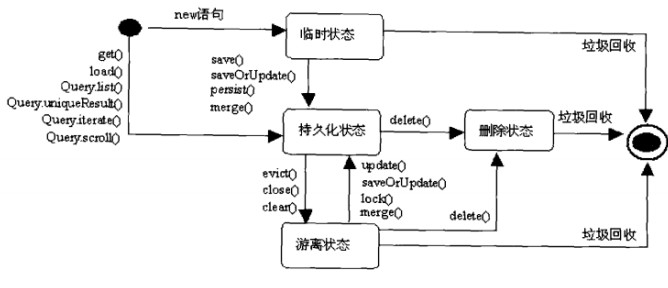在持久化层角度上说,一个java对象在生命周期中可以处于四个状态:
1. 临时状态(Transient):刚用new创建的对象,未被持久化,此时并没有处于Session缓存中
2. 持久化状态(Persistent):已经持久化,加入到了Session缓存中。
3. 游离状态(Detached):已经被持久化,但不再处于Session缓存中,此时数据库中依旧有记录
4. 删除状态(removed):不再处于Session缓存中,并且已经计划将其从数据库中删除。
下图是上述四种状态的描述:

缓存(Session/SessionFactoy)
Session 缓存是hibernate的第一级缓存,由于Session对象的生命周期通常对应一个数据库事务或者一个应用事务,因此它的缓存是事务范围的缓存,这一级缓存是必须的。
第二级缓存默认的情况下是打开的,由SessionFactoy管理,由于SessionFactory对象的生命周期和应用程序的整个进程对应,因此第二级缓存是进程范围或集群范围的缓存
SessionFactory对象的创建代价很昂贵,线程安全,它为所有的应用程序线程所共享。它只创建一次,通常是在应用程序启动的时候,由一个 Configuraion 的实例来创建。
一级缓存:
得到Session的方法有如下两个:
openSession :每次都是新的Session,并且要手动close
getCurrentSession:从上下文找,如已有那么用已经有的Session,如没有,创建新的;不需要手动close,当一个线程提交或撤销事务后hibernate自动关闭session对象;
<property name=”current_session_context_class”>thread</property>
current_session_context_class有四个值,两个是常用的:
thread:在线程里找是否有已经存在的Session(getCurrentSession());(最常用)
jta:主要针对数据库分布式而用;(处理多个数据库事务)
Transaction tx=session.beginTransaction(); //第一次执行get方法,先到Session 缓存中查找oid为1的User对象,由于不存在这样的对象,要向数据库查询, User u1=(User)session.get(User.class, new Long(1)); //第二次执行,由于在缓存中查找时能找到,故不再向数据库中执行sql语句 User u2=(User)session.get(User.class, new Long(1)); System.out.println(u2==u1);//true tx.commit();
二级缓存:
不是所有的数据都适合放在二级缓存中
下面这几种情况就不适合加载到二级缓存中:
- 经常被修改的数据
- 绝对不允许出现并发访问的数据
- 与其他应用共享的数据
下面这己种情况合适加载到二级缓存中:
- 数据更新频率低
- 允许偶尔出现并发问题的非重要数据
- 不会被并发访问的数据
- 常量数据
- 不会被第三方修改的数据
二级缓存功能是配置二级缓存插件来实现的,有org.hibernate.cache.CacheProvider借口,它充当缓存插件与Hibernate之间的适配器 .
常用的二级缓存插件
EHCache org.hibernate.cache.EhCacheProvider
OSCache org.hibernate.cache.OSCacheProvider
SwarmCahe org.hibernate.cache.SwarmCacheProvider
JBossCache org.hibernate.cache.TreeCacheProvider
load、iterate默认使用二级缓存;
list默认往二级缓存加数据,但是查询的时候不使用,如果query用二级缓存,需打开查询缓存,只有查询条件一样时才会调用二级缓存
<property name="cache.use_query_cache">true</property> <!--查询缓存 -->
调用query的setCachable(true)方法指明使用二级缓存
如果配置了查询缓存,以下代码只发送一次sql请求:
public void testQueryCache() {
Session session = sf.openSession();
session.beginTransaction();
List<Category> categories = (List<Category>)session.createQuery("from Category").setCacheable(true).list();
session.getTransaction().commit();
session.close();
Session session2 = sf.openSession();
session2.beginTransaction();
List<Category> categories2 = (List<Category>)session2.createQuery("from Category").setCacheable(true).list();
session2.getTransaction().commit();
session2.close();
}
EHCache的配置 hibernate.cfg.xml
<hibernate-configuration>
<session-factory>
<!-- 设置二级缓存插件EHCache的Provider类-->
<property name="hibernate.cache.provider_class">org.hibernate.cache.EhCacheProvider</property>
<!-- 启动"查询缓存" -->
<property name="hibernate.cache.use_query_cache">true</property>
</session-factory>
</hibernate-configuration>
ehcache.xml
<ehcache>
<!-- maxElementsInMemory为缓存对象的最大数目, eternal设置是否永远不过期,timeToIdleSeconds对象处于空闲状态的最多秒数,timeToLiveSeconds对象处于缓存状态的最多秒数 -->
<diskStore path="java.io.tmpdir"/>
<defaultCache maxElementsInMemory="10000" eternal="false" timeToIdleSeconds="300" timeToLiveSeconds="600" overflowToDisk="true"/>
</ehcache>
****.hbm.xml
<hibernate-mapping>
<class>
<!-- 设置该持久化类的二级缓存并发访问策略 read-only read-write nonstrict-read-write transactional-->
<cache usage="read-write"/>
</class>
</hibernate-mapping>
二级缓存也可以用annotation配置:http://docs.jboss.org/hibernate/annotations/3.4/reference/zh_cn/html_single/
缓存算法有:
LRU(Least Recently Used)、LFU(Least Frequently Used)、FIFO(First In First Out)
使用时通常在缓存配置文件中加入:MemoryStoreEvictionPolicy="LRU"